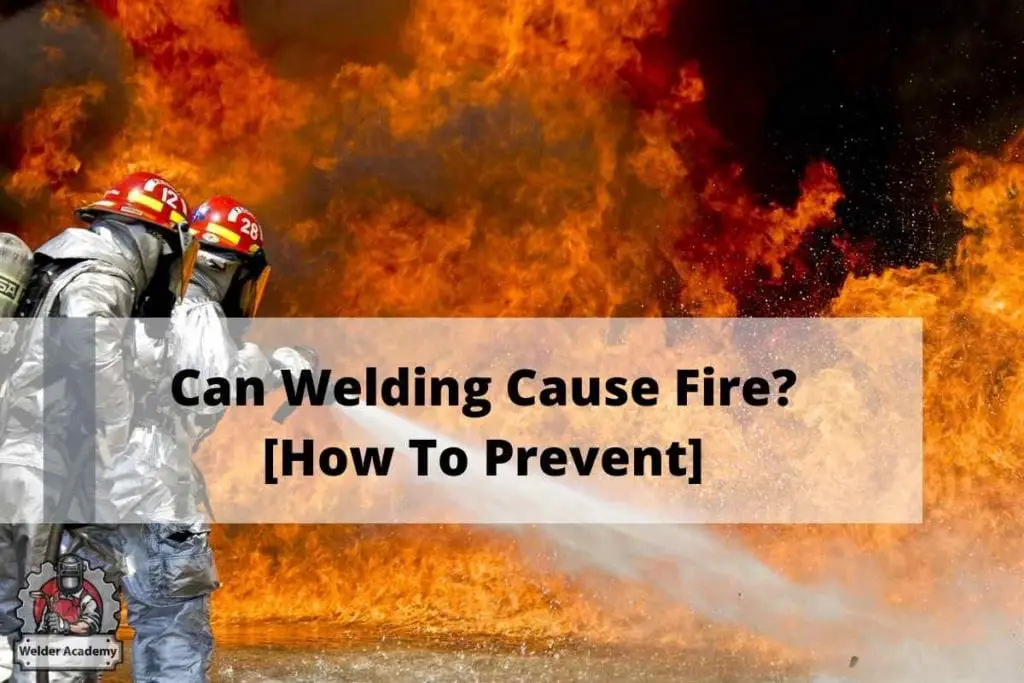You may want to be a professional welder or weld as a hobby. In both cases, it is essential to learn all the dangers involved in welding. By now, you must know that you will have to deal with hot metals, molten metals, and chemicals while welding. There will be flames and sparks flying around you. So, can welding cause a fire?
Welding fires can occur when enough safety measures are not taken. Sparks, melted metal, and torch flames can get out of control. Fire can also result from flammable materials coming in touch with the hot workpiece and welding flames.

In this article, I will talk about the reasons for fire incidents during welding. You will also learn how to prevent welding fire accidents and what to do if a fire breaks out.
How Can Welding Cause Fire?
Do you know the welding arc can heat up to ten thousand degrees Fahrenheit? Imagine what can happen if flammable objects get in contact with such heat. Fire hazards can occur from the sparks, spatter, molten metal, and torch flames created by the arc.
The spark and spatter from welding are much hotter and more dangerous as they carry bits and pieces of melted metal. The American Welding Society (AWS) has safety prevention rules for welders. There, it is mentioned that sparks and splatter can spray up to 35 feet (10m) from the area where welding takes place. [source]
They can fall on clothing, pipe holes, cracks, and any small opening. So, you must protect any flammable materials within a 35-foot radius of the welding area.
Flammable materials will catch fire when they touch or get near a hot workpiece. Torch flames are also dangerous as they can ignite flammable objects and chemicals within a few feet of each other. Not all fires explode or start instantly. Splatter and sparks can fall on materials and burn slowly. You may not even notice it at first.
AWS has a list of common combustible materials that welders need to be aware of:
- Building materials such as paper, wood, clothing, plastic, chemicals, flammable liquids, and gasses.
- Building floors, roofs, and partitions.
- External combustible materials such as leaves, grass, branches, and twigs.
How To Prevent Fire In Welding?
As you can see, there is a high chance of fire accidents during welding. Fire hazards burn you and others around the welding area. Besides, it can damage your welding materials and property. However, you can prevent fire accidents by following some safety measures.
Here is what you can do to prevent fire hazards:
Prepare the Welding Area
The first step of welding begins by preparing the area of welding. Working indoors or outdoors, you must inspect the surrounding area to make sure there are no materials that can cause a fire. At least 35-feet from the welding space.
When you find any flammable substance, remove it from the spot. You can also choose another area for welding. If none of these is possible, you have to cover the flammable materials with non-flammable materials.
Clean the welding area and prevent external flammable substances such as dry leaves, grass, and twigs from entering the welding area. It would be better to weld in a place specifically made for welding.
Be aware of Sparks, Splatter, and Molten Metals
The welding and cutting process creates sparks as the metal starts to melt. They can be the source of ignition. As mentioned before, the sparks and splatter can travel up to 35 feet and fall even further.
Therefore, keep all combustible objects far away from the working station. Construction sites are often loaded with various combustible materials. These are wood, cardboard boxes, rags, paper, paper bags, plastic, cans of paint, chemicals, gas cylinders, flammable liquids, and fumes. None of these items should be around.
These items should also be kept away from a hot workpiece, a hot welder, and electrocuted equipment and wires.
Fix Holes and Cracks
So, you have cleared the area of all kinds of flammable objects. But have you taken care of the pipe holes, cracks, and other openings? This is one mistake many welders make. They do not cover up the holes and cracks in the area. Molten metal, sparks, and splatters can get into the holes and cracks. These holes and cracks may have particles of flammable materials that can cause a fire.
When the sparks and melted metals fall into the holes and cracks, they do not start fires right away. It may take seconds, minutes, or even hours. They can cause smoke in the working area and explosions.
So, you must find the cracks, holes, and openings around the 35 feet of the welding space. Then cover them with non-flammable materials so that nothing gets inside.
Keep Fire Extinguishers Nearby
Welders are trained for their safety. You may already know how important it is to keep fire extinguishers and other fire-controlling equipment. If you do not know how to use a fire extinguisher, you must learn about it.
Your welding workplace must have fire extinguishers. You should know where the cylinders are so that you can reach them as soon as you spot fire hazards. Learn about the different types of extinguishers as they work differently on fire based on the fire’s source material.
You can use a Type A fire extinguisher for fires ignited by wood, paper, clothing, and combustible solids. A Type B extinguisher is for eliminating fires from flammable liquids (oil, grease, and paint).
Wear Protective Clothing and Gear
Do not neglect your personal safety. You must always wear Personal Protection Equipment, or PPE, all the time during welding. Welders are at high risk of getting burns from flames, sparks, splatter, and melted metals. You can also get burned by hot workpieces or welding machines.
Therefore, you must always wear protective clothing and gear. Put on welding jackets, gloves, boots, caps, respirators, helmets, and goggles. Do not roll up your jacket sleeves or pant cuffs. Sparks can fly in there and even in open pockets. Wear long-sleeved jackets and long pants to cover the boots. Never wear clothes made of combustible materials.
These are some fire prevention measures you can take to avoid fire accidents during welding. Welders often keep people around when they work on projects involving flames, sparks, spatter, and melted metals.
The person keeps observing the welding process to make sure no fire breaks out. If they see any sign of fire, they signal the welders to stop immediately.
Also, the welder should clean the working space after welding and spend 20 to 30 minutes checking if a fire took place.
What To Do If Fire Occurs?
Now, what if fires start in the welding area? What should you do then? First of all, know where your fire extinguishers are so that you get them when you need them. You should know where the fire alarms are to alert others about the hazard. Then find the emergency exits.
Apart from fire extinguishers, welders should have a fire hose with water pressure, sand buckets, fire-resistant blankets, and other fire-fighting equipment. Never think of using water to put off a welding fire.
So, you have to be prepared to control fire incidents. When a fire actually breaks out, you must not panic. If it is a small fire, you can easily control it with the fire extinguisher or other mentioned equipment. Remember, use the extinguisher on the materials that are burning, not on the flames.
The fire can get out of control. In that case, turn off the welding machine and other electronic devices if you can. Then inform others about the fire and leave the area as soon as possible.
Conclusion
So, can welding cause a fire? Yes, welding can cause fire hazards if safety measures are neglected. However, by taking preventive measures, you can avoid fire accidents during welding. Protecting yourself and the property is your responsibility. Therefore, you must educate yourself on fire prevention and safety.
